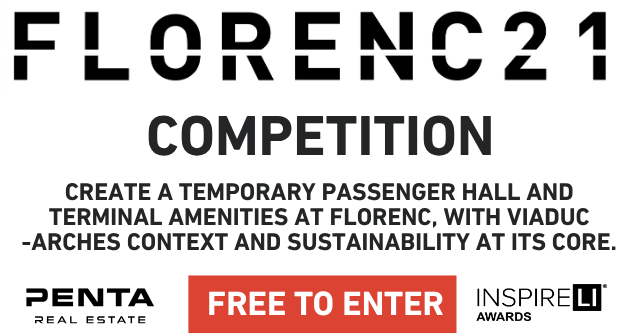REVITALISATION OF THE STATION BUILDING IN SLANÝ
Idea projektu
Cílem návrhu je vytvořit architektonický soubor, který citlivě reaguje na historický kontext místa, ale zároveň splňuje současné požadavky na funkci, provozní komfort, technickou přístupnost a estetické vnímání veřejného prostoru. Návrh nepřistupuje k historii jako k dogmatu, ale jako k živé vrstvě, s níž je možné vést věcný a tvůrčí dialog. Budova proto nevzniká jako kopie minulosti nebo jako solitérní projev současnosti - ale jako kombinace obou přístupů, v níž má každý z nich svou jasně definovanou roli a vymezený prostor. Základní koncepce návrhu je založena na vědomém kontrastu - mezi minulostí a současností, mezi veřejnou funkcí a soukromým využitím, mezi zachováním tradiční hmotové a prostorové struktury a vložením nové formy, která tvarově a materiálově reaguje na potřeby dneška. Tento kontrast není chápán jako konfrontace, ale jako zdroj identity a charakteru celé budovy. Právě v napětí mezi oběma rozdílnými přístupy vzniká autentický výraz, který umožňuje, aby budova byla jak nositelem historické paměti, tak součástí současného života
Popis projektu
Návrh řeší komplexní architektonickou úpravu budovy s důrazem na jasné vymezení dvou kontrastních částí, které odrážejí odlišný historický kontext a funkční náplň budovy. Tento kontrast je vědomě uplatněn v exteriéru i interiéru a tvoří základní kompoziční a významotvorný princip celého návrhu. Historická část budovy byla rehabilitována do podoby odpovídající jejímu původnímu výrazu a proporcím. Tato část slouží jako zázemí nádraží s veřejnými prostory a kancelářemi Českých drah. Novější část budovy je určena pro funkci penzionu s ubytovací kapacitou a odpovídajícím provozním zázemím. Architektonický přístup zde při respektování tradičního měřítka a rytmu doplňují soudobé prvky v podobě lehké ocelové konstrukce, která tvoří vnější schodiště, balkonový ochoz a výtahovou šachtu. Tato konstrukce je přiznána a stylizována jako samostatný architektonický motiv a vnáší do celku lehkost, transparentnost a industriální charakter, odpovídající kontextu železničního areálu. Vizuální propojení obou částí budovy zajišťuje horizontální členění - historická římsa v moderním pojetí plynule přechází do systému ocelových profilů, které jsou ve stejné výškové úrovni. Tento prvek slouží jako spojovací linie napříč různými architektonickými výrazy a zároveň sjednocuje hmotný celek. Dvě prostorové dominanty budovy určují její výraz a vztah k okolí. První z nich je obnovený historický vstupní portál, navržený na základě archivních dokumentů s důrazem na detail, symetrii a historickou důstojnost. Druhou dominantou je ocelová železniční cisterna, do jejíž karoserie je integrován venkovní výtah. Tento prvek nejen funkčně řeší přístupnost budovy, ale vytváří také silný symbolický odkaz na původní průmyslový a dopravní charakter místa. Projekt tak nabízí citlivou kombinaci obnovy a současného doplnění, čímž vzniká architektura, která je funkčně propracovaná, kontextuálně ukotvená a výrazově sebevědomá - aniž by se pokoušela o historizující kopii nebo formální gesto.
Technické informace
Revitalizace budovy je navržena s důrazem na dlouhodobou udržitelnost, energetickou účinnost a technickou integritu budovy. Veškeré zásahy respektují historický charakter budovy a zároveň využívají moderní stavební technologie a materiály, které umožňují splnit současné standardy, aniž by byly ohroženy architektonické hodnoty budovy. Jedním z klíčových aspektů návrhu je kvalitní tepelná obálka budovy. Budova je zateplena pomocí tenkovrstvých izolačních systémů, které zajišťují vysoký tepelný standard při zachování původních proporcí fasády a bez negativního vlivu na plasticitu nebo profilaci historických prvků. To umožňuje modernizaci budovy v souladu s požadavky na energetickou účinnost, aniž by došlo k vizuální deformaci. Zvláštní pozornost byla věnována dennímu osvětlení interiéru, zejména v půdním prostoru. Pro tento účel byl zvolen systém střešních světel NEBESYS, který umožňuje účinný přísun přirozeného světla, aniž by narušoval souvislou rovinu střešního pláště. Tento systém nejenže přispívá k provoznímu komfortu a kvalitě vnitřního prostředí, ale zároveň nenarušuje monumentální výraz budovy, což je vzhledem k jejímu charakteru obzvláště důležité. Ocelová konstrukce, která je součástí nového architektonického prvku na straně penzionu, je technicky řešena jako samostatná stavba nezávislá na původní budově. Skládá se z válcovaných ocelových profilů a je spojena kombinací svařovaných a šroubových spojů, čímž je zajištěna jak její statická tuhost, tak možnost případné budoucí demontáže či úpravy. Celý návrh vychází ze zásad šetrného a uvědomělého přístupu k revitalizaci, kdy každé technické řešení podporuje dlouhodobou životnost stavby, uživatelský komfort a respekt k historickému a urbanistickému kontextu místa.


